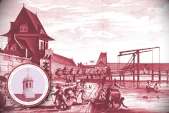IV.5 Economy, Labour and Slavery

The economy and labour force in Batavia largely depended on the use of forced labour. This involved thousands of slaves. Half the city consisted of slaves, the majority imported from the tradional slave markets of India, Sulawesi, Bali and the islands of eastern Indonesia. Most slaves were privately owned and among these private owners were also many Asian citizens and small agricultural entrepreneurs.
The local economy in the Ommelanden included the production of sugar, rice and a variety of vegetables and fruit. Thousands of little contracts between horticulturalists and workers, traders and producers bear witness to the industriousness of the ‘orang Betawi’, the free (Muslim) Asians of mixed descent. The free (Christian) Asians of mainly Indian descent, the Mardijkers, were active landowners and traders, many of whom lived in their own quarter just east of the city walls, and some in kampongs like Tugu and Depok. An early list of landowners reveals the identity of the earliest 'Portuguese' inhabitants of late-seventeenth century Tugu.




